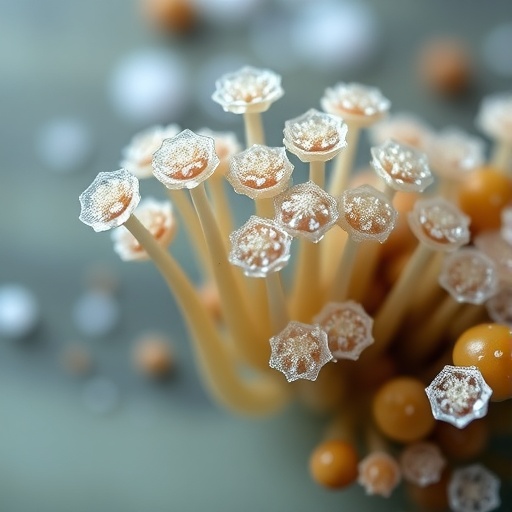Diatom DNA metabarcoding has emerged as a pivotal tool in the field of environmental monitoring, particularly for assessing the health and biodiversity of freshwater ecosystems. A groundbreaking study by Smucker, Pilgrim, and Nietch sheds light on a crucial aspect of this methodology: the impact of freezing periphyton samples and varying storage durations on the integrity of diatom DNA. This research not only enhances our understanding of aquatic health assessments but also paves the way for more reliable outcomes in future studies.
The researchers meticulously explored how freezing methods might influence the DNA quality of periphyton samples, which are vital for understanding stream ecosystems. Periphyton, comprised of algae, bacteria, and other microorganisms attached to submerged surfaces, plays a significant role in nutrient cycling and serves as a food source for various aquatic organisms. However, the challenge arises when environmental scientists need to collect and analyze these samples for genetic studies, particularly when faced with logistical delays.
One critical concern in ecological research is how sample preservation techniques affect the quality of the genetic material upon which subsequent analyses rely. In their study, the authors aimed to ascertain whether freezing periphyton samples would compromise the viability of diatom DNA for metabarcoding, which is essential for detecting the presence and abundance of various diatom species in freshwater areas. This is particularly relevant for tracking changes in community composition in response to environmental stressors.
During the investigation, the researchers conducted a series of controlled experiments, assessing DNA extraction efficiency from periphyton samples that had been subjected to various freezing durations. Their approach included comparing the quality of diatom DNA from frozen samples with that from freshly collected ones. By carefully analyzing the DNA through advanced metabarcoding techniques, they aimed to establish whether long-term freezing interfered with the detection capacity of the targeted diatom species.
Findings from the study were quite revealing. The team discovered that both freezing methods and storage durations had little to no negative impact on the diatom DNA quality. This result is particularly promising for ecologists and environmental scientists who often contend with the constraints of fieldwork logistics, including transportation difficulties and other delays. The research highlights that the integrity of DNA is preserved over extended periods of freezing, opening new avenues for efficient sample processing without compromising data quality.
This study also contributes significantly to the ecological understanding of how external stressors affect stream health. By employing diatom DNA metabarcoding, researchers can now obtain a more comprehensive picture of the ecological state of waterways without the fear of sample degradation from freezing. This advancement enhances the accuracy of biodiversity assessments and makes it easier for scientists to understand how changes in land use, agricultural practices, and pollution are impacting aquatic ecosystems.
Further extending the implications of this study, the research suggests that environmental monitoring using diatom DNA metabarcoding can be conducted with greater flexibility and accuracy. This could lead to more frequent and widespread assessments of stream health, as the logistical burdens associated with immediate sample processing are alleviated. Understanding the dynamics of freshwater ecosystems is crucial given the ongoing global biodiversity crisis and the critical role that freshwater environments play in supporting diverse life forms.
Moreover, the authors also emphasized the practical applications of their findings for regulatory agencies and conservationists tasked with managing aquatic resources. With a reliable method for assessing diatom communities through preserved samples, stakeholders can implement better-informed conservation strategies and effectively monitor the ecological impacts of anthropogenic activities.
The importance of robust scientific methodologies in environmental monitoring cannot be understated. As environmental issues continue to evolve, monitoring techniques must adapt accordingly. This study exemplifies the kind of innovative research that is necessary to ensure the sustainability and health of our freshwater ecosystems in the face of growing global challenges.
In conclusion, Smucker et al.’s research offers significant insights into the relationship between sample preservation techniques and the quality of genetic analysis in the context of environmental stressor assessment. Their findings provide an optimistic outlook for freshwater monitoring practices and underline the need for continuous development of methodologies that enhance the reliability and accuracy of ecological assessments.
This pioneering work not only sheds light on a critical methodological concern in aquatic ecology but also serves as a call to action for researchers and policymakers alike. Effective preservation of genetic material can contribute to informed decisions that safeguard our invaluable freshwater resources and promote biodiversity conservation efforts.
As science continues to unravel the complexities of our ecosystems, findings such as these remind us of the importance of methodological rigor and the potential for innovative approaches to enhance our understanding of ecological dynamics in a rapidly changing world.
Subject of Research: The impact of freezing periphyton samples and storage duration on diatom DNA metabarcoding.
Article Title: Freezing periphyton samples and storage duration do not affect the use of diatom DNA metabarcoding to determine effects of stressors on streams.
Article References:
Smucker, N.J., Pilgrim, E.M., Nietch, C.T. et al. Freezing periphyton samples and storage duration do not affect the use of diatom DNA metabarcoding to determine effects of stressors on streams. Environ Monit Assess 197, 1360 (2025). https://doi.org/10.1007/s10661-025-14753-5
Image Credits: AI Generated
DOI: https://doi.org/10.1007/s10661-025-14753-5
Keywords: Diatom DNA metabarcoding, periphyton, freezing, environmental monitoring, stream health, biodiversity, ecological assessment.




